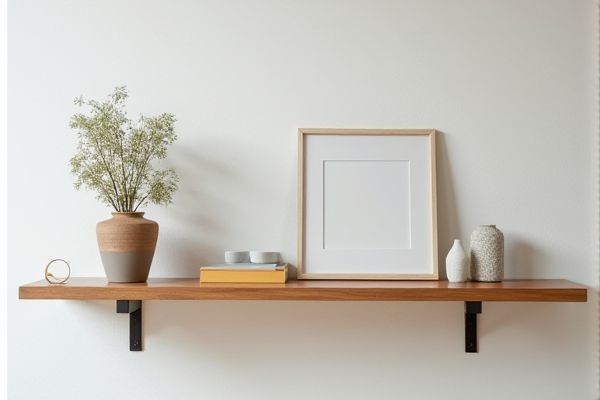
Wall-mounted shelves offer sturdy storage with visible brackets, complementing traditional and industrial interiors, while floating shelves create a sleek, minimalist look by concealing supports for a clean, modern aesthetic. Discover which option best suits your space and style preferences in this detailed comparison.
Table of Comparison
| Feature | Wall-mounted Shelf | Floating Shelf |
|---|---|---|
| Installation | Uses visible brackets or supports attached to the wall | Brackets hidden inside the shelf for a clean, bracket-free look |
| Aesthetics | Traditional look with visible hardware | Modern, minimalist design with no visible supports |
| Weight Capacity | Generally higher due to external brackets | Moderate; depends on internal mounting hardware |
| Installation Difficulty | Relatively easier due to visible brackets | More complex; requires precise alignment and mounting |
| Customization | Variety of bracket styles and materials available | Limited by internal hardware design |
| Maintenance | Easy to access and adjust brackets | Harder to repair without removing shelf |
| Best Use | Heavy items, traditional decor | Light to medium items, modern interiors |
Introduction to Wall-Mounted and Floating Shelves
Wall-mounted shelves are sturdy storage solutions anchored directly into the wall studs, providing enhanced weight support for heavier items such as books and decor. Floating shelves feature hidden brackets that create a minimalist, clean look, making them ideal for displaying lightweight objects in modern interior designs. Both shelf types maximize space utilization while offering distinct aesthetic and functional benefits.
Key Differences Between Wall-Mounted and Floating Shelves
Wall-mounted shelves are supported by visible brackets or supports attached directly to the wall, providing robust stability and often higher weight capacity. Floating shelves feature concealed mounting hardware, creating a sleek, minimalist appearance that visually "floats" without visible supports. The main distinction lies in installation complexity and aesthetic impact: wall-mounted shelves emphasize sturdiness and traditional design, while floating shelves prioritize modern style and subtle elegance.
Design and Aesthetic Comparison
Wall-mounted shelves typically feature visible brackets or supports, offering a more traditional and sturdy appearance that complements rustic or industrial decor. Floating shelves, with their concealed mounting hardware, provide a sleek, minimalist aesthetic that enhances modern and contemporary interiors by creating a clean, streamlined look. The choice between the two depends on desired visual impact, with floating shelves emphasizing simplicity and wall-mounted shelves highlighting functional charm.
Installation Process: Wall-Mounted vs Floating Shelves
Wall-mounted shelves typically require brackets and anchors for secure installation, often involving drilling into studs for maximum support. Floating shelves feature hidden internal brackets, creating a sleek, bracket-free appearance but may need precise measurements and stronger wall anchors to ensure stability. Your choice depends on the desired aesthetic and willingness to handle varying installation complexities.
Load Capacity and Strength Considerations
Wall-mounted shelves typically offer higher load capacity and greater strength due to their support brackets anchored directly into studs, making them ideal for heavy items and storage needs. Floating shelves, while visually minimalist and modern, rely on hidden internal brackets and are generally better suited for lighter objects to avoid sagging or damage. When selecting your shelf type, consider the weight of your items and the wall structure to ensure proper installation and safety.
Space-Saving Solutions: Which Shelf Wins?
Wall-mounted shelves provide sturdy support and can hold heavier items, making them ideal for maximizing vertical storage in tight spaces. Floating shelves offer a sleek, minimalist look that visually frees up room and enhances the sense of openness in your space. For optimal space-saving solutions, your choice depends on the weight capacity needed and the aesthetic you prefer, with floating shelves excelling in creating an uncluttered feel and wall-mounted shelves winning for practical storage.
Best Uses for Wall-Mounted Shelves
Wall-mounted shelves are ideal for displaying heavier items such as books, kitchenware, or decorative pieces due to their robust support and secure attachment to studs in the wall. Unlike floating shelves, they can handle substantial weight, making them a practical choice for storage in living rooms, kitchens, and garages. Your space benefits from their versatility in organizing both functional and aesthetic items while maintaining easy accessibility.
Best Uses for Floating Shelves
Floating shelves are ideal for displaying decorative items, books, or small plants without visible brackets, creating a clean and modern aesthetic. They maximize space in smaller rooms or tight areas, making your walls both functional and stylish. These shelves work best in living rooms, bedrooms, or offices where a minimalist look is desired.
Cost and Maintenance Analysis
Wall-mounted shelves typically cost less due to simpler installation and more available materials, while floating shelves demand higher prices because of concealed brackets and premium finishes. Maintenance for wall-mounted shelves is straightforward, as exposed hardware allows easy tightening and repainting, whereas floating shelves require careful handling to avoid damaging hidden supports. Your choice may hinge on budget constraints and willingness to invest in upkeep for a sleeker, modern look.
Choosing the Right Shelf for Your Needs
Wall-mounted shelves offer strong support and are ideal for heavy items or large storage, attaching directly to studs for maximum stability. Floating shelves provide a sleek, minimalist appearance by hiding brackets, perfect for showcasing decor or small items without visual clutter. Your choice depends on the weight capacity you need and the style you prefer for your space.
 homyna.com
homyna.com